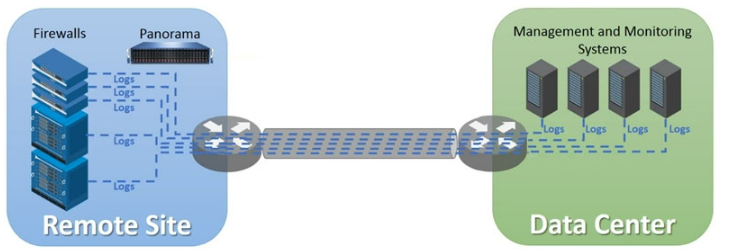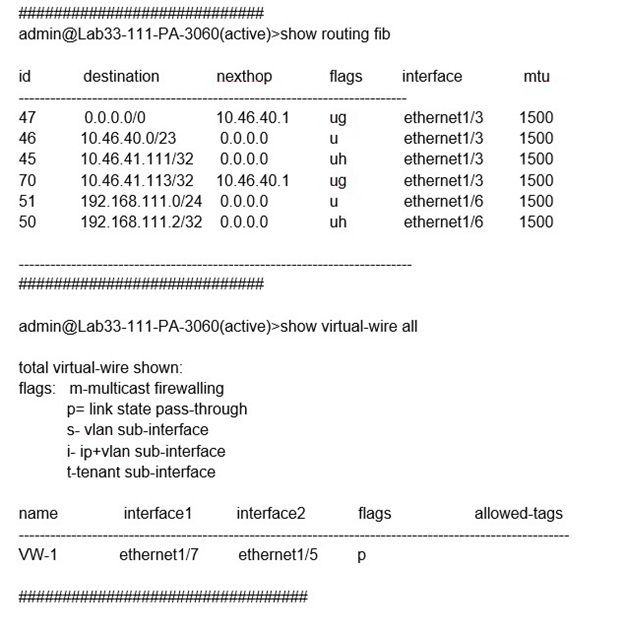Which two key exchange algorithms consume the most resources when decrypting SSL traffic? (Choose two.)
A. ECDSA
B. ECDHE
C. RSA
D. DHE
Explanation:
The two key exchange algorithms that consume the most resources when decrypting SSL
traffic are ECDHE and DHE. These are both Diffie-Hellman based algorithms that enable
perfect forward secrecy (PFS), which means that they generate a new and unique session
key for each SSL/TLS session, and do not reuse any previous keys. This enhances the
security of the encrypted communication, but also increases the computational cost and
complexity of the key exchange process.
ECDHE stands for Elliptic Curve Diffie-Hellman
Ephemeral, which uses elliptic curve cryptography (ECC) to generate the session key. DHE
stands for Diffie-Hellman Ephemeral, which uses modular arithmetic to generate the
session key. Both ECDHE and DHE require more CPU and memory resources than RSA,
which is a non-PFS algorithm that uses public and private keys to encrypt and decrypt the
session key.
References:
Key Exchange Algorithms, Best Practices for Enabling SSL
Decryption, PCNSE Study Guide (page 60)
An auditor is evaluating the configuration of Panorama and notices a discrepancy between the Panorama template and the local firewall configuration. When overriding the firewall configuration pushed from Panorama, what should you consider?
A. The firewall template will show that it is out of sync within Panorama.
B. The modification will not be visible in Panorama.
C. Only Panorama can revert the override.
D. Panorama will update the template with the overridden value.
Detailed Explanation:
When a local override is applied on a firewall (modifying a Panorama-pushed configuration):
B. The modification will not be visible in Panorama.
Panorama does not automatically detect or display locally overridden values on the firewall.
The firewall retains its local changes, but Panorama still shows its original template configuration.
Why the Other Options Are Incorrect:
A. Panorama does not automatically flag templates as "out of sync" due to local overrides (manual review is required).
C. Both Panorama and the firewall CLI can revert overrides (Panorama is not the only method).
D. Panorama does not auto-update templates with locally overridden values (changes must be manually pushed from Panorama).
Best Practice:
Use "Force Template Values" in Panorama to eliminate local overrides and enforce centralized management.
Reference:
Panorama Local Overrides Documentation
Which two policy components are required to block traffic in real time using a dynamic user group (DUG)? (Choose two.)
A. A Deny policy for the tagged traffic
B. An Allow policy for the initial traffic
C. A Decryption policy to decrypt the traffic and see the tag
D. A Deny policy with the "tag" App-ID to block the tagged traffic
Explanation:
Dynamic User Groups (DUGs) in Palo Alto Networks firewalls are used to dynamically assign users to groups based on tags pushed from external systems like Cortex XSOAR, XDR, or via the XML API. These allow for real-time enforcement of security policies without requiring user logout/login or group refreshes.
To block traffic in real time using DUGs, the following policy components are needed:
🔹 A. A Deny policy for the tagged traffic
This is the actual policy that references the Dynamic User Group and blocks traffic for users dynamically added to the group.
Once a user is tagged (e.g., as "malicious" or "violator"), this rule becomes effective immediately, blocking their access based on the DUG membership.
🔹 B. An Allow policy for the initial traffic
Before the user is tagged and added to the DUG, they still need to be allowed to generate traffic so they can be evaluated or monitored.
This initial allow policy ensures the traffic is visible and can be tagged (e.g., by a monitoring or detection system like Cortex XDR).
❌ Why the other options are incorrect:
C. A Decryption policy to decrypt the traffic and see the tag:
Tags and DUG membership are independent of traffic decryption. DUG enforcement is based on user identity and tag, not packet content.
D. A Deny policy with the "tag" App-ID to block the tagged traffic:
Tags are not App-IDs. A tag is an identifier for grouping users in DUGs, not an application signature. So there is no "tag" App-ID.
🔍 Reference:
Palo Alto Networks – Dynamic User Groups:
Dynamic User Groups (DUGs) Overview
Best Practices for DUG Implementation:
Palo Alto Live Community – Using Dynamic User Groups to Quarantine Users
A remote administrator needs access to the firewall on an untrust interface. Which three options would you configure on an interface Management profile to secure management access? (Choose three)
A. HTTPS
B. SSH
C. Permitted IP Addresses
D. HTTP
E. User-IO
Explanation:
To securely allow remote management access on an untrust interface, the Interface Management Profile should include:
A. HTTPS – Enables secure web-based management (GUI/API access).
B. SSH – Allows secure CLI access for administrators.
C. Permitted IP Addresses – Restricts management access to specific trusted IPs (critical for security on an untrust interface).
Why the Others Are Incorrect:
D. HTTP – Unencrypted and insecure; should never be enabled on an untrust interface.
E. User-IO – Used for physical console access, irrelevant for remote management.
Best Practices:
Always disable HTTP and Ping on untrust interfaces.
Use certificate-based authentication for HTTPS/SSH if possible.
Reference:
Palo Alto Interface Management Profile Docs
Exhibit.
An organization has Palo Alto Networks NGFWs that send logs to remote monitoring and
security management platforms The network team has reported excessive traffic on the
corporate WAN How could the Palo Alto Networks NGFW administrator reduce WAN traffic
while maintaining support for all the existing monitoring/security platforms?
A. Any configuration on an M-500 would address the insufficient bandwidth concerns
B. Forward logs from external sources to Panorama for correlation, and from Panorama send them to the NGFW
C. Configure log compression and optimization features on all remote firewalls
D. Forward logs from firewalls only to Panorama and have Panorama forward logs to other external services
Explanation:
In the image, we see multiple firewalls at a remote site sending logs directly to both Panorama and to various management and monitoring systems at the data center, which consumes significant WAN bandwidth.
To reduce WAN traffic while maintaining the existing log visibility:
🔄 Centralize log forwarding:
Send logs only once across the WAN — from the firewalls to Panorama — and let Panorama handle the log forwarding to all other systems (SIEM, monitoring tools, etc.).
This drastically cuts down on duplicate log traffic over the WAN.
🔍 Why the other options are incorrect:
A. Any configuration on an M-500 would address the insufficient bandwidth concerns:
❌ Incorrect. The M-500 is a Panorama appliance, and its configuration affects log storage/management but doesn't inherently reduce WAN bandwidth unless used properly in architecture like option D.
B. Forward logs from external sources to Panorama for correlation, and from Panorama send them to the NGFW:
❌ Reversed logic. Logs go from NGFWs to Panorama, not the other way around.
C. Configure log compression and optimization features on all remote firewalls:
❌ PAN-OS does not support log compression across WAN links for remote log forwarding. So this option is not feasible.
🧠 Best Practice:
Use Panorama in "Log Collector mode" or dedicated log collectors to centralize logs.
Use Panorama’s Log Forwarding feature to relay logs to external monitoring and SIEM systems.
This keeps only one copy of each log traveling across the WAN, minimizing traffic and duplication.
📚 Reference:
Palo Alto Networks – Log Forwarding
Palo Alto Networks – Best Practices for Distributed Log Collection
Refer to the exhibit.
Which will be the egress interface if the traffic's ingress interface is ethernet1/7 sourcing
from 192.168.111.3 and to the destination 10.46.41.113?
A. ethernet1/6
B. ethernet1/3
C. ethernet1/7
D. ethernet1/5
Explanation:
In the second image, VW ports mentioned are 1/5 and 1/7. Hence it can not be a part of
any other routing. So if any traffic coming as ingress from 1/7, it has to go out via 1/5. The egress interface for the traffic with ingress interface ethernet1/7, source
192.168.111.3, and destination 10.46.41.113 will be ethernet1/5.
This is because the traffic
will match the virtual wire with interfaces ethernet1/5 and ethernet1/7, which is configured
to allow VLAN-tagged traffic with tags 10 and 201. The traffic will also match the security
policy rule that allows traffic from zone Trust to zone Untrust, which are assigned to
ethernet1/7 and ethernet1/5 respectively2. Therefore, the traffic will be forwarded to the
same interface from which it was received, which is ethernet1/53.
A firewall administrator wants to be able at to see all NAT sessions that are going ‘through a firewall with source NAT. Which CLI command can the administrator use?
A. show session all filter nat-rule-source
B. show running nat-rule-ippool rule "rule_name
C. show running nat-policy
D. show session all filter nat source
A superuser is tasked with creating administrator accounts for three contractors. For compliance purposes, all three contractors will be working with different device-groups in their hierarchy to deploy policies and objects. Which type of role-based access is most appropriate for this project?
A. Create a Dynamic Read only superuser
B. Create a Dynamic Admin with the Panorama Administrator role
C. Create a Device Group and Template Admin
D. Create a Custom Panorama Admin
Explanation: Custom Panorama Admin: Custom Panorama Admin roles allow you to customize the elements of Panorama that an administrator can access. You can hide tabs in the web interface, you can set specific items in Panorama to read-only, or you can limit an administrator’s access to Panorama plugins. Custom Panorama Admin roles require planning and configuration, but they provide extensive flexibility because you can control what administrators can access through the web interface or the CLI. Device Group and Template Admin: Device Group and Template Admin roles also require configuration because there are no built-in examples. These Admin Roles allow you to define which Panorama templates or Panorama device groups an administrator can access and configure. You can hide tabs in the web interface or set specific items to read only to control what administrators can configure.
What would allow a network security administrator to authenticate and identify a user with a new BYOD-type device that is not joined to the corporate domain?
A. an Authentication policy with 'unknown' selected in the Source User field
B. an Authentication policy with 'known-user' selected in the Source User field
C. a Security policy with 'known-user' selected in the Source User field
D. a Security policy with 'unknown' selected in the Source User field
Explanation: For a network security administrator to authenticate and identify a user with a
new BYOD-type device that is not joined to the corporate domain, the most effective
method is to use an Authentication policy targeting users not yet identified by the system.
A. an Authentication policy with 'unknown' selected in the Source User field:
An Authentication policy allows the firewall to challenge unidentified users for
credentials. By selecting 'unknown' in the Source User field, the policy targets
users who have not yet been identified by the firewall, which would include users
on new BYOD devices not joined to the domain.
Once the user provides valid credentials, the firewall can authenticate the user and
map their identity to subsequent sessions, enabling the application of user-based
policy rules and monitoring.
This approach ensures that new and unknown devices can be properly authenticated and
identified without compromising security or requiring the device to be part of the corporate
domain.
Which GloDalProtecI gateway setting is required to enable split-tunneting by access route, destination domain and application?
A. Tunnel mode
B. Satellite mode
C. IPSec mode
D. No Direct Access to local networks
| Page 2 out of 33 Pages |
| Previous |